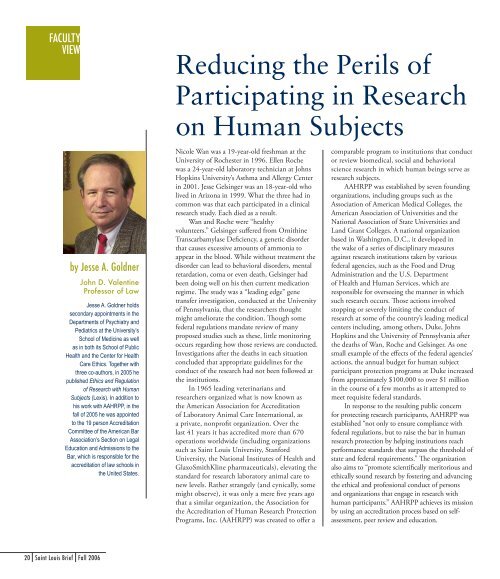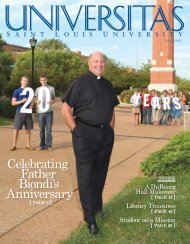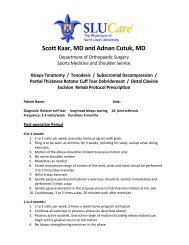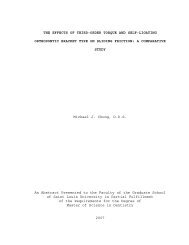willkommen in - Saint Louis University
willkommen in - Saint Louis University
willkommen in - Saint Louis University
You also want an ePaper? Increase the reach of your titles
YUMPU automatically turns print PDFs into web optimized ePapers that Google loves.
FACULTy<br />
vieW In 2002 I was <strong>in</strong>vited to jo<strong>in</strong> AAHRPP’s<br />
by Jesse A. goldner<br />
John D. Valent<strong>in</strong>e<br />
Professor of Law<br />
Jesse A. Goldner holds<br />
secondary appo<strong>in</strong>tments <strong>in</strong> the<br />
Departments of Psychiatry and<br />
Pediatrics at the <strong>University</strong>’s<br />
School of Medic<strong>in</strong>e as well<br />
as <strong>in</strong> both its School of Public<br />
Health and the Center for Health<br />
Care Ethics. Together with<br />
three co-authors, <strong>in</strong> 2005 he<br />
published Ethics and Regulation<br />
of Research with Human<br />
Subjects (Lexis). In addition to<br />
his work with AAHRPP, <strong>in</strong> the<br />
fall of 2005 he was appo<strong>in</strong>ted<br />
to the 19 person Accreditation<br />
Committee of the American Bar<br />
Association’s Section on Legal<br />
Education and Admissions to the<br />
Bar, which is responsible for the<br />
accreditation of law schools <strong>in</strong><br />
the United States.<br />
Reduc<strong>in</strong>g the Perils of<br />
Participat<strong>in</strong>g <strong>in</strong> Research<br />
on Human Subjects<br />
Nicole Wan was a 19-year-old freshman at the<br />
<strong>University</strong> of Rochester <strong>in</strong> 1996. Ellen Roche<br />
was a 24-year-old laboratory technician at Johns<br />
Hopk<strong>in</strong>s <strong>University</strong>’s Asthma and Allergy Center<br />
<strong>in</strong> 2001. Jesse Gels<strong>in</strong>ger was an 18-year-old who<br />
lived <strong>in</strong> Arizona <strong>in</strong> 1999. What the three had <strong>in</strong><br />
common was that each participated <strong>in</strong> a cl<strong>in</strong>ical<br />
research study. Each died as a result.<br />
Wan and Roche were “healthy<br />
volunteers.” Gels<strong>in</strong>ger suffered from Ornith<strong>in</strong>e<br />
Transcarbamylase Deficiency, a genetic disorder<br />
that causes excessive amounts of ammonia to<br />
appear <strong>in</strong> the blood. While without treatment the<br />
disorder can lead to behavioral disorders, mental<br />
retardation, coma or even death, Gels<strong>in</strong>ger had<br />
been do<strong>in</strong>g well on his then current medication<br />
regime. The study was a “lead<strong>in</strong>g edge” gene<br />
transfer <strong>in</strong>vestigation, conducted at the <strong>University</strong><br />
of Pennsylvania, that the researchers thought<br />
might ameliorate the condition. Though some<br />
federal regulations mandate review of many<br />
proposed studies such as these, little monitor<strong>in</strong>g<br />
occurs regard<strong>in</strong>g how those reviews are conducted.<br />
Investigations after the deaths <strong>in</strong> each situation<br />
concluded that appropriate guidel<strong>in</strong>es for the<br />
conduct of the research had not been followed at<br />
the <strong>in</strong>stitutions.<br />
In 1965 lead<strong>in</strong>g veter<strong>in</strong>arians and<br />
researchers organized what is now known as<br />
the American Association for Accreditation<br />
of Laboratory Animal Care International, as<br />
a private, nonprofit organization. Over the<br />
last 41 years it has accredited more than 670<br />
operations worldwide (<strong>in</strong>clud<strong>in</strong>g organizations<br />
such as Sa<strong>in</strong>t <strong>Louis</strong> <strong>University</strong>, Stanford<br />
<strong>University</strong>, the National Institutes of Health and<br />
GlaxoSmithKl<strong>in</strong>e pharmaceuticals), elevat<strong>in</strong>g the<br />
standard for research laboratory animal care to<br />
new levels. Rather strangely (and cynically, some<br />
might observe), it was only a mere five years ago<br />
that a similar organization, the Association for<br />
the Accreditation of Human Research Protection<br />
Programs, Inc. (AAHRPP) was created to offer a<br />
comparable program to <strong>in</strong>stitutions that conduct<br />
or review biomedical, social and behavioral<br />
science research <strong>in</strong> which human be<strong>in</strong>gs serve as<br />
research subjects.<br />
AAHRPP was established by seven found<strong>in</strong>g<br />
organizations, <strong>in</strong>clud<strong>in</strong>g groups such as the<br />
Association of American Medical Colleges, the<br />
American Association of Universities and the<br />
National Association of State Universities and<br />
Land Grant Colleges. A national organization<br />
based <strong>in</strong> Wash<strong>in</strong>gton, D.C., it developed <strong>in</strong><br />
the wake of a series of discipl<strong>in</strong>ary measures<br />
aga<strong>in</strong>st research <strong>in</strong>stitutions taken by various<br />
federal agencies, such as the Food and Drug<br />
Adm<strong>in</strong>istration and the U.S. Department<br />
of Health and Human Services, which are<br />
responsible for oversee<strong>in</strong>g the manner <strong>in</strong> which<br />
such research occurs. Those actions <strong>in</strong>volved<br />
stopp<strong>in</strong>g or severely limit<strong>in</strong>g the conduct of<br />
research at some of the country’s lead<strong>in</strong>g medical<br />
centers <strong>in</strong>clud<strong>in</strong>g, among others, Duke, Johns<br />
Hopk<strong>in</strong>s and the <strong>University</strong> of Pennsylvania after<br />
the deaths of Wan, Roche and Gels<strong>in</strong>ger. As one<br />
small example of the effects of the federal agencies’<br />
actions, the annual budget for human subject<br />
participant protection programs at Duke <strong>in</strong>creased<br />
from approximately $100,000 to over $1 million<br />
<strong>in</strong> the course of a few months as it attempted to<br />
meet requisite federal standards.<br />
In response to the result<strong>in</strong>g public concern<br />
for protect<strong>in</strong>g research participants, AAHRPP was<br />
established “not only to ensure compliance with<br />
federal regulations, but to raise the bar <strong>in</strong> human<br />
research protection by help<strong>in</strong>g <strong>in</strong>stitutions reach<br />
performance standards that surpass the threshold of<br />
state and federal requirements.” The organization<br />
also aims to “promote scientifically meritorious and<br />
ethically sound research by foster<strong>in</strong>g and advanc<strong>in</strong>g<br />
the ethical and professional conduct of persons<br />
and organizations that engage <strong>in</strong> research with<br />
human participants.” AAHRPP achieves its mission<br />
by us<strong>in</strong>g an accreditation process based on selfassessment,<br />
peer review and education.<br />
<strong>in</strong>itial Council on Accreditation, which<br />
determ<strong>in</strong>es the status of applicant organizations.<br />
In 2005 I served as the Council’s first<br />
chairperson and cont<strong>in</strong>ue to participate by<br />
serv<strong>in</strong>g as a member of the group and by<br />
conduct<strong>in</strong>g site evaluation visits on its behalf.<br />
The <strong>in</strong>vitation to jo<strong>in</strong> the Council came about<br />
for three reasons, each related to my work<br />
at SLU: (1) For some eighteen years I had<br />
been a member of (and, from 1998 through<br />
2003, had chaired) SLU’s Institutional Review<br />
Board (IRB). This is an <strong>in</strong>terdiscipl<strong>in</strong>ary<br />
group, <strong>in</strong>clud<strong>in</strong>g both scientists and nonscientists,<br />
primarily comprised of faculty from<br />
throughout the <strong>University</strong>, but also <strong>in</strong>clud<strong>in</strong>g<br />
non-<strong>University</strong>-affiliated <strong>in</strong>dividuals. The<br />
IRB, through a peer review process, evaluates<br />
<strong>in</strong>dividual proposals to conduct research<br />
<strong>in</strong>volv<strong>in</strong>g human subjects by faculty, staff and<br />
graduate students at the <strong>University</strong>. The purpose<br />
is to ensure that ethical pr<strong>in</strong>ciples are followed,<br />
primarily by see<strong>in</strong>g to it that <strong>in</strong>vestigators are<br />
m<strong>in</strong>imiz<strong>in</strong>g risks to research participants and<br />
obta<strong>in</strong><strong>in</strong>g appropriate <strong>in</strong>formed consent from<br />
these subjects. (2) Much of my academic writ<strong>in</strong>g<br />
<strong>in</strong> the last decade has focused on the regulation<br />
of research. Most recently, I co-authored a law<br />
school casebook on the subject. (3) S<strong>in</strong>ce 1988<br />
I had regularly conducted site evaluations of<br />
other American law schools for purposes of their<br />
accreditation on behalf of the Accreditation<br />
Committee of the American Bar Association’s<br />
Section on Legal Education and Admissions<br />
to the Bar. This familiarized me with the<br />
accreditation process, albeit of a very<br />
different type.<br />
How does AAHRPP work? AAHRPP is not<br />
affiliated with the government. It is <strong>in</strong>stitutions,<br />
<strong>in</strong>clud<strong>in</strong>g universities, hospitals and free-stand<strong>in</strong>g<br />
research facilities, that voluntarily apply to<br />
AAHRPP for accreditation. Applicants must<br />
complete a wide-rang<strong>in</strong>g questionnaire and<br />
submit extensive support<strong>in</strong>g materials, <strong>in</strong>clud<strong>in</strong>g<br />
their policies and procedures, all relat<strong>in</strong>g to how<br />
their <strong>in</strong>stitution goes about protect<strong>in</strong>g the rights<br />
of those who serve as research participants. This<br />
is <strong>in</strong> an effort to evaluate that they meet some<br />
twenty different standards that <strong>in</strong>clude seventyfive<br />
separate elements. Among the issues explored<br />
are the <strong>in</strong>volvement of organizational leaders<br />
and the adequacy of resources they provide<br />
to the process. In review<strong>in</strong>g the competency<br />
and sophistication of the <strong>in</strong>stitution’s research<br />
The purpose is to <strong>in</strong>sure that<br />
ethical pr<strong>in</strong>ciples are followed,<br />
primarily by see<strong>in</strong>g to it that<br />
<strong>in</strong>vestigators are m<strong>in</strong>imiz<strong>in</strong>g<br />
risks to research participants.<br />
“<br />
”<br />
review units (typically the IRBs), we exam<strong>in</strong>e<br />
their abilities to (a) assess risks and benefits; (b)<br />
oversee the appropriate recruitment and selection<br />
of subjects; (c) protect participants’ privacy and<br />
the confidentiality of the data obta<strong>in</strong>ed; and<br />
(d) monitor the process of obta<strong>in</strong><strong>in</strong>g <strong>in</strong>formed<br />
consent from participants and the content of the<br />
<strong>in</strong>formation provided to them.<br />
Another focus is that of the <strong>in</strong>vestigators<br />
themselves: their familiarity with research ethics,<br />
their abilities to follow applicable laws and<br />
regulations and their understand<strong>in</strong>g that the<br />
protections of the rights and welfare of research<br />
participants is their primary concern. Attention<br />
also is paid to the nature of the contractual<br />
relationship between the organization itself and<br />
outside agencies such as pharmaceutical and<br />
medical device companies that sponsor research.<br />
This <strong>in</strong>volves ensur<strong>in</strong>g that there is appropriate<br />
communication of <strong>in</strong>formation that might affect<br />
the ongo<strong>in</strong>g oversight of research protocols by<br />
IRBs as well as maximiz<strong>in</strong>g the likelihood that<br />
the benefits of the knowledge obta<strong>in</strong>ed through<br />
research are realized and the <strong>in</strong>terests of current<br />
and future participants are protected. F<strong>in</strong>ally, the<br />
standards address how the organization responds<br />
to concerns of research participants and engages<br />
<strong>in</strong> outreach efforts by offer<strong>in</strong>g educational<br />
opportunities to participants to enable them to<br />
better understand research.<br />
After the submitted materials are reviewed,<br />
AAHRPP appo<strong>in</strong>ts a site evaluation team,<br />
typically comprised of two to five members who<br />
have tra<strong>in</strong><strong>in</strong>g and experience <strong>in</strong> conduct<strong>in</strong>g<br />
evaluations and who have no affiliations with the<br />
applicant <strong>in</strong>stitution. They will spend between<br />
two and five days at the <strong>in</strong>stitution, depend<strong>in</strong>g<br />
on its size and number of research projects at the<br />
<strong>in</strong>stitution. They then draft a lengthy and highly<br />
detailed report describ<strong>in</strong>g what they encountered<br />
at the <strong>in</strong>stitution, <strong>in</strong>clud<strong>in</strong>g an exam<strong>in</strong>ation<br />
of protocols and other records and <strong>in</strong>terviews<br />
with <strong>in</strong>vestigators, staff and members of the<br />
IRB. Ultimately, these reports are reviewed by<br />
the Council on Accreditation which determ<strong>in</strong>es<br />
if the standards have been met so as to merit<br />
accreditation. Not <strong>in</strong>frequently, <strong>in</strong>stitutions are<br />
placed <strong>in</strong> an “accreditation pend<strong>in</strong>g” category<br />
when the Council determ<strong>in</strong>es that additional<br />
efforts need to be made by the <strong>in</strong>stitution. At the<br />
present time some thirty-n<strong>in</strong>e <strong>in</strong>stitutions have<br />
met accreditation standards, though nearly four<br />
hundred are “<strong>in</strong> the pipel<strong>in</strong>e” and will be site<br />
visited with<strong>in</strong> the next year or two.<br />
The process, both for <strong>in</strong>stitutions and<br />
for those who conduct site evaluations and<br />
participate <strong>in</strong> Council reviews, is an arduous<br />
one. As critical as the development of ongo<strong>in</strong>g<br />
scholarship <strong>in</strong> this area may be, it is equally<br />
important that those of us who spend much of<br />
our time <strong>in</strong> the proverbial ivory tower, recognize<br />
the need to “descend” and expend some of our<br />
efforts <strong>in</strong> the hands-on work that may more<br />
directly affect the ability of researchers and their<br />
<strong>in</strong>stitutions to protect research participants like<br />
Nicole Wan, Ellen Roche and Jesse Gels<strong>in</strong>ger. As<br />
AAHRPP accreditation becomes more prevalent,<br />
it is quite likely that the safety of research subjects<br />
will <strong>in</strong>crease and the lives and health of countless<br />
others will benefit as well.<br />
20 Sa<strong>in</strong>t <strong>Louis</strong> Brief Fall 2006 Fall 2006 Sa<strong>in</strong>t <strong>Louis</strong> Brief 2

















